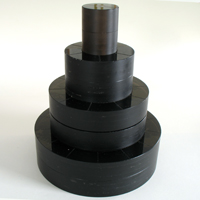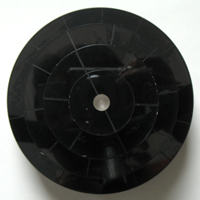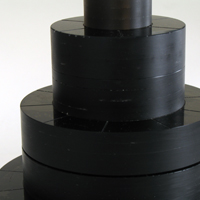


| PERIODIC ROUND TABLE |
| Introduction | | Papers | | Explanation | | Order | | About the Author |
 |
 |
 |
The Periodic Round Table
is a unique three-dimensional model of the Periodic Table, and an elegant
spatial arrangement of the chemical elements that is symmetrical and mathematical.
It possesses a high degree of order because it is based exclusively on
the system of ideal electronic configuration, which in turn is the basis
of periodicity among the elements. In the Periodic Round Table the electron
shells are filled in the same order as the elements themselves appear,
demonstrating a holistic relationship between the chemistry of the elements
and the orbital descriptions of their electrons. It is the ultimate refinement
of Mendeleev's scheme, and an educational tool that will take us into
the twenty-first century and beyond. The Periodic Table is presented in such a way that the technical details
do not obstruct your appreciation of the beauty of this concept; it is
more than a mound of data, it is a veritable icon of our knowledge of
the universal order. The handcrafted models of the Periodic Round Table
are made of naturally finished hardwood, permanently branded symbols and
atomic numbers of the elements and attractively packaged in a giftable
box. Included with each unit is a concise explanation of the reasoning
behind the Periodic Round Table. We have recently updated the Periodic
Round Table to include newly approved symbols for elements up to atomic
number 109. THE NEED FOR THREE DIMENSIONS Why do we need three dimensions when all the information on the Periodic
Table can be displayed in the two dimensional periodic table? While the flat chart may have mathematical
regularity, the Periodic Round Table has that plus cylindrical symmetry
which directly displays the underlying quantum orbitals. In other words,
the Periodic Round Table is a circular map of the system of electronic
configuration that can tell us more about the ordering of the elements
than a planar chart. THE OBJECTIVES Even if you, the observer, don't know what is meant by atom, electron,
or element, you may still feel on seeing the Periodic Round Table that
there is something worth looking into. It is to the goal of creating knowledge
that this effort is dedicated. As well it should be, because the average
person has not shared in the bounty of knowledge that twentieth century
science has created. Only a tiny fraction of the public knows enough about
the elements of matter to participate in the great debate over future
energy technology; for example whether we should continue to employ nuclear
power. The Periodic Round Table can help people who don't have a scientific
background get a sense of this discussion because of the unique way the
actinide elements are displayed at the base. Nuclear issues may well determine
the survival of the planet. Nuclear weapons, nuclear power, nuclear waste
– every person has the right to learn about these issues and where
the world is headed. The primary objective then is to assist people in
gaining this understanding. The second objective is to preserve this knowledge in the form of durable
objects. How much of the printed and electronic data of our era will survive
another thousand years? Not much thought has been given by our society
to permanently recording its accomplishments, and protecting them from
the assaults of time. Records of two thousand years ago were inscribed
on better materials than we use now. Ancient materials – stone,
pottery, parchment – had a longer information half–life than
their modern counterparts like paper and plastic. Language itself changes
over time, to the point where it becomes impossible to reconstruct the
intended meanings of ancient texts, even where the symbols themselves
may survive. The Periodic Round Table though communicates not only through
symbolism but derives its meaning from three dimensional geometry as well.
It is in fact a kind of totem or storytelling sculpture and can pass its
story along to posterity; like a totem, it contains within its proportions
all the information necessary to maintain the essential knowledge of the
elements, independent of any particular symbolism. A system of communication that transcends symbols is more lasting than
one that depends on the written character. To this end, the Periodic Round
Table will go into production in stone, glass, ceramic, and bronze, on
a one of a kind basis, in addition to the present hardwood version. These
more durable materials will propagate this knowledge into future societies
that may succeed our own. With care the hardwood model should certainly
last several lifetimes – and it will never become obsolete! Although
new elements may be discovered and named, the same basic plan will extend
into perpetuity. The Periodic Round Table will provide not only you but
your descendants a source of pleasure and knowledge for generations. --- Although the Periodic Round Table looks different from the standard flat, Periodic Table you are familiar with, there is nothing scientifically controversial about this approach. In fact, Periodic Tables based on electronic configuration have been in print for many years. The Periodic Round Table was patented in 1980 and went into production in 1995. |